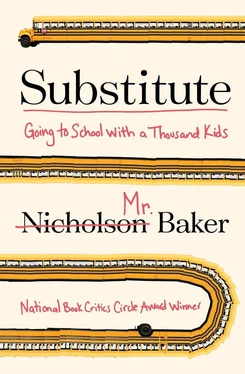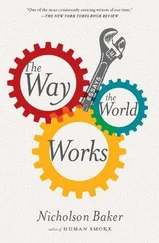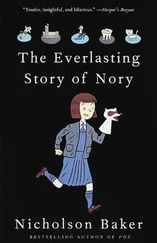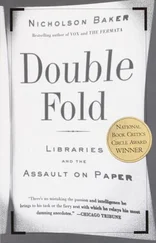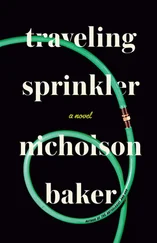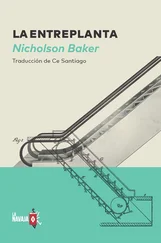One more class to go: seventh-grade biology with Mrs. Painter in Team Orinoco. “Yesterday you finished diagramming mitosis and meiosis, and comparing and contrasting the two,” Mrs. Painter said to the class. She sounded flat-voiced and tired. “That should be done by now. If it’s not done, you need to do it at home, or before you start your capacity matrix. Today, as a whole class, we’re going to watch a video on how plants reproduce. We’re going to talk about the video. Afterward, I’m going to give you your last capacity matrix. It has every assignment on it that you’ll have to do from now until the last week of school.”
Howard, a little jumpy kid, raised his hand. “Do we work through the last week of school?”
“If we’re not done,” said Mrs. Painter.
“What if everything’s done, then what?” asked Whitney.
“We’ll deal with that when we get there — if we get there,” said Mrs. Painter. She reviewed asexual and sexual reproduction. “How many parent cells are in mitosis?”
One!
“How many parent cells are in meiosis?”
Two!
She called us to the front of the room and turned on the YouTube movie. “Today’s topic is the exciting process of plant reproduction in angiosperms,” said an animated amoeboid female-voiced blob named Pinky. “A fruit develops from the ovary of a plant, which doesn’t exactly sound appetizing. Pumpkins, green beans, tomatoes, squash — these all developed from the ovary of a flowering plant.”
Mrs. Painter stopped the video. “Who knew plants had ovaries? Raise your hand.”
“What are ovaries?” said Whitney.
“Female baby-making parts,” said Maureen.
“Oh, I know all about that,” said Whitney.
The video resumed — and Pinky began bombing us with vocabulary. We heard about stamens, filaments, anthers , and pollen , which was the sperm of the plant. Then the female parts: the pistil , the stigma , the style , and the ovary . Next came the sepals and physical pollination, effected by a bee. More words from Pinky followed at a brisk trot: Pollen grains held two kinds of cells, a tube cell and a generative cell . The tube cell grew down into the tube nucleus , and the generative cell traveled down the tube cell into the ovary, where it divided into two sperm cells, both of which sought out a component of the ovary called an ovule . Each ovule had an egg cell and two polar nuclei . One sperm cell fertilized the egg cell, while the other sperm cell joined up with the two polar nuclei to form a triploid cell that would develop into the endosperm , in a process called double fertilization . Pinky’s cheery voice made me sleepy, and by the time we got to the two polar nuclei my head started to droop. I think Mrs. Painter saw me dozing off, and I felt bad about that.
“Okay, this is what we’re going to do,” said Mrs. Painter. I straightened up in my chair. “Before you work on your Keynote, I’m going to give you a sticky note and have you write one thing you learned about plant reproduction, and one question that you have. Based on what you guys put down, I’m going to make a mini-lesson for tomorrow, so we can get the missing parts. Back to your seats.”
Paloma and Bobby, from Mr. Fields’s class, sat at a table near me by the windows. I waved at them. “What’s up back here?” I said.
“NOW YOU ARE TRANSITIONING BACK TO YOUR TABLES,” said Mrs. Painter. “THIS IS A REDIRECT I SHOULDN’T HAVE TO BE MAKING.”
She passed out sticky notes. Paloma said something softly to me I didn’t hear.
“I’m what?”
“You’re the quietest teacher I’ve ever known,” Paloma said.
“Oh, no, I’m very talkative,” I whispered, “it’s just that when I’m an ed tech I don’t like to disrupt the class. When I’m actually a teacher up there I flail around and talk loudly.”
“What do you teach?” asked Bobby.
“Anything they want me to,” I said.
“You’re like a go-to?” Bobby said.
“I’m a sub, so science, English, whatever.”
“That’s what my mom was,” Paloma said. “Now she’s studying to be a nurse.”
“How’s it going for her?” I asked.
“Pretty good. She’s in the middle of classes.”
Bobby said, “My mom was thinking of going back to college. Then she found out that the people in the program who’d graduated couldn’t get a job anywhere. So she’s not.”
I said, “A lot of people are starting to think that it costs too much to go to college. There’s a lot you can do without it.”
“I wanted to go to college to be a psychologist,” said Bobby. “Then I thought about that, and now I want to be a firefighter. I’m fourteen, and I can start now.”
“At fourteen you can be a firefighter?” I said.
“Well, you can be a junior firefighter. Not a Grade A real firefighter, but they train you to be a firefighter.”
“I’M READY WHEN YOU ARE,” said Mrs. Painter. “HOLD ON TO YOUR STICKY NOTES. I’m going to collect them after we go over our matrix. On your capacity matrix, you need to put your name on it, and date started, which would be today. So six four twenty-fourteen. This is what you’re going to be working on from now to the last day of school. All of the assignments that you have for the rest of the year are right on this paper, front side, back side.”
I studied the capacity matrix, which was a sideways chart filled with boxes. Down the left side were learning targets and “Baby Steps,” and a box that said Knows key terms . To the right were levels of achievement — Emerging, Partially Proficient, Proficient, and Advanced — and lists of activities: BrainPOPs, quizzes, and projects, including an interesting-sounding “Build a Beast Project.” On the far right were boxes where Mrs. Painter could sign to show that each learning target and Baby Step had been successfully completed. To score a 4, the highest possible score, a student had to demonstrate a higher order of thinking from Marzano’s Taxonomy —Robert Marzano being the Colorado-based educational consultant who was the source of the neo-Aristotelian learning poster that was up in almost every classroom.
“Since you guys are losing your iPads next week,” Mrs. Painter went on, “I am going to give you the time today to finish your BrainPOPs and the vocab. I’m going to save the mini-lesson that we were going to do today until Monday. WHAT ARE OUR LAST TWO LEARNING TARGETS? Someone raise your hand and read one of them. Maddy. Whitney, find your paper and point to them. Learning target one and learning target two. Understands how variations in the behavior and traits of an offspring may permit some of them to survive a changing environment .”
“Wha?” said a voice.
“What does that mean?” said Mrs. Painter. “What are we asking, what do we need to know? Alton?”
“Like possible adaptions, physically and mentally, adaptions to get along with their surroundings and circumstances.”
“Exactly. Did you hear that, Whitney?”
“Yes,” said Whitney.
“What did he say?”
Whitney said nothing.
Mrs. Painter turned to Alton. “Repeat it, because you said it very well.”
“Like mental and physical adaptions to be able to cope with surroundings and circumstances.”
“Exactly. So we’re looking at how animals or plants have adapted to allow them to be able to survive in a changing environment. The next learning target is Understands the physical and behavioral features of plants and animals that help them live in different environments . So what do you think we’re going to look at there? What do you know about biomes, different biomes? What were you going to say, Anne?”
Читать дальше
